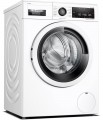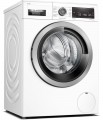Additional programmes
It is worth noting that the cotton, synthetics, wool, rinse, drain and spin programmes are mandatory for almost any washing machine, and there is no need to specifically specify their presence. Therefore, only more rare and specific modes are indicated here:
custom programme,
quick wash,
delicate,
hygiene (baby care),
sportswear,
dark garmentjeans,
shirts,
outerwear,
down clothes,
bedding,
blankets,
refresh (no washing),
night wash and
self clean, etc. Here is a description of these and some other popular modes:
— Custom programme. A programme, all the parameters of which can be configured manually: set the temperature, duration, spin speed, additional processing features, etc. at your discretion. It significantly expands the possibilities for working with the machine and allows you to select the optimal modes for special cases when the list of ready programmes is not enough. In the simplest models, a "custom programme" is created based on one of the standard modes, in which the
...user makes his changes. For the next use of such a programme, it is enough to select it on the control panel without setting the settings again. In more advanced units, it is possible to store several unique programmes in memory at once.
— Quick wash. The quick wash programme is especially useful for lightly soiled items that do not require thorough treatment (for example, casual clothes after a hot day). In addition to time, such a programme also allows you to significantly save water and electricity. Well, of course, it can be real salvation if the time for washing is limited, but you can’t do without it. Often, the design provides more than one quick wash mode — for example, for 15 and 30 minutes. It allows you to choose the option that is optimal in terms of speed/economy and thoroughness.
— Delicate wash. A programme designed for sensitive materials — fine silk, cambric, lace fabrics, some types of nylon and polyester, etc. Usually, washing in this mode occurs with an increased amount of water and the permissible load does not exceed 2 kg — all this reduces the friction of items among themselves, and large volumes of water also allow you to effectively rinse the fabric. Spinning is usually carried out at low speeds or skipped altogether. And in some models, other options for delicate washing may be provided; they should be specified separately. However, if you plan to wash things that require especially careful handling, you cannot do without this programme.
— Hygiene (baby care). The mode implies increased thoroughness of processing. It is designed to remove dirt, pathogenic bacteria, etc. from the processed items as much as possible. Such effective processing is especially important for clothes intended for young children Therefore, most often this programme is just called “baby care”. This mode has two main features. Firstly, by default, washing is carried out at an elevated temperature — this ensures the effective removal of contaminants and the destruction of germs. Secondly, rinsing after washing is done with great care — so that even in the most hard-to-reach folds there are no traces of detergent left. In some machines, other nuances are also provided; they should be specified separately.
— Sportswear. Special programme for processing sportswear between workouts. Such clothes are usually soaked with sweat but there are not so many other contaminants on them. It is sufficiently resistant to mechanical stress but does not always allow high temperatures. Workouts can take place daily, so spending a lot of time on washing can be a luxury — after all, things must also dry. This is taken into account in this mode: “sportswear” washing usually involves a small load and low temperature, and reduced spin speeds may also be provided. However, the specific features of this programme, again, do not hurt to clarify separately.
— Dark garment. A key feature of dark fabrics is that even minimal detergent residues are clearly visible on them. Therefore, a mandatory feature of the programme for dark clothes is thorough rinsing. In addition, this mode often provides gentle processing in general — so that things retain their original colour longer and do not form wrinkles on them.
- Denim clothes. Despite the overall strength and reliability, denim is quite sensitive to intensive washing. Therefore, in washing machines for such things, a special gentle mode with a lower temperature and a reduced speed of rotation of the drum can be provided. This mode is also well suited for thin shirts, which is why in some models it is called accordingly - for example, "shirts / jeans".
- Shirts. Special program for delicate washing of shirts and other business style clothes. The key feature of this mode can be called a small load at low speeds and a short spin time, in order to avoid the formation of wrinkles on the fabric.
- Down jackets (down things). Natural fluff easily accumulates water and is very reluctant to "return" it. Therefore, one of the features of this program is usually long pauses in the rotation of the drum - so that the water that has accumulated in the product has time to drain effectively.
- Outerwear. A special program for washing demi-season and winter jackets with an emphasis on respect for the filler of the upper wardrobe. The mode involves the use of low temperature, low rotational speed of the drum and gentle spin. This program also helps outerwear fabrics retain their waterproof properties.
- Bed sheets. Program adapted for the gentle washing of sheets, duvet covers and pillowcases. For best results, it is suggested to load the same type of bed linen into the washer drum. The program is usually aimed at work with a small load (2-4 kg).
— Blankets. Care mode for duvets and bedspreads of various types. As a rule, this program is designed for washing voluminous bed linen in the manner of duvets. One of its features is usually long pauses in the rotation of the drum - so that the water that has accumulated in the product has time to drain effectively. This program is also suitable for washing lined and downy items.
— Refresh (no washing). A special mode for processing things that do not require a full wash but need cleaning. A typical example of such things is clothes that have been “idle” for a long time, accumulating dust and unpleasant odours, or things that have been worn once and not for long. In the refresh mode, the machine does not use water but other methods of processing fabrics. One of the most popular options is an intense stream of hot steam: it removes or destroys substances responsible for an unpleasant smell, blows out dust from fabrics that could accumulate there, and also facilitates the removal of wrinkles on fabrics, which are smoothed out when dry. bad. Another option for refresh is blowing with active oxygen. This method does not remove dust as effectively, but it perfectly eliminates unpleasant odours. Anyway, when refreshing, detergents are not used, and clothes are not wetted with water, and in extreme cases, slightly moistened. Often things can be used almost immediately after being removed from the drum.
— Self clean. A utility programme for cleaning the insides of the machine from various contaminants that may accumulate during operation. In this mode, things are not loaded, and the drum is intensively washed with hot water, which allows you to effectively clean it and destroy pathogenic bacteria. However, it is worth noting that in many models this programme practically does not differ from ordinary washing at a high temperature (about 90 °C). So even in the absence of a special self-cleaning mode, similar results can be achieved by running a high-temperature wash with an empty drum without spinning.
- Night wash. Low noise program designed for washing machine at night and similar conditions. In this mode, the machine works as silently as possible: with smooth movements of the drum, low spin speed and turning off the sound signals of the equipment. The rest of the washing parameters are usually set manually.Jet rinse
The presence of a jet rinse function in the machine. Such rinsing, by the name, is carried out by strong jets of water sprayed from special nozzles. It ensures higher efficiency than the traditional method and reduces water consumption and washing time.
Energy class (new)
This parameter characterizes the efficiency of electricity consumption by the washing machine. Classes are designated in Latin letters from A to G in ascending order of energy consumption. This was originally conceived until more energy-efficient models pulled up to class A, which eventually received the marking A+, A++, and A+++. Further development of technology has made it possible to go even further, and in order not to produce pluses in energy efficiency labelling, in March 2021, manufacturers returned to the previous indices from G to A, where A is the most energy efficient washing machine. Accordingly, the 2021 models will have modern markings, while older models will be marked in the same way.
Smartphone control
The ability to control the washing machine from a smartphone, tablet or other similar gadget. To do this, you need to install a special application on your gadget. In this case, the connection can be made via
Bluetooth or
Wi-Fi. The advantages and disadvantages of each method are obvious - the operating distance. So Wi-Fi allows you to control the device from anywhere in the world, while Bluetooth allows you to control it in close proximity. Control from a smartphone often turns out to be more convenient, understandable and intuitive to use than the unit’s own control panel. Another advantage is that the control gadget can receive various messages from the machine: about the start, end and overall progress of washing, about failures and malfunctions, etc.
Opening angle
Door opening angle in front-loading washing machines. The wider the hatch opens, the easier it is to load and remove laundry from the drum of the device. The most convenient option is
180° opening the door. In simpler models of washing machines, the hatch opens to a smaller angle (usually in the range from 120° to 180°).
Noise level (spin)
The maximum noise level produced by the machine during operation. Most often indicated for spinning — this is the noisiest mode of operation; for units without spinning (such as semiautomatic devices), this paragraph indicates the overall volume or the volume in the noisiest mode.
The
quieter the machine works, the more comfortable it is for others. This moment is especially critical if there are small children in the house. However, the decibel used to measure loudness is a non-linear unit, and the actual noise level is best estimated from comparative tables in special sources.
Country of origin
The country in which the washing machine was manufactured (according to the manufacturer's statement). Despite the fact that production facilities in
China are often used to assemble household appliances, specifically among washing machines there are many products assembled in Europe (
Germany,
Italy,
Poland,
Romania,
Slovakia,
Slovenia, Turkey) or in the post-Soviet space (
Belarus,
Russia,
Ukraine).
There are many stereotypes about how the build quality depends on the specific "homeland" of the device. However, most of them are not justified: the thoroughness of quality control does not depend directly on the location of production. And within individual brands, the situations in this regard can be completely opposite: relatively speaking, for one company, Polish-assembled machines can be considered more reliable than Romanian ones, and for another, vice versa. In addition, such information (about which plant a given brand has is better) often turns out to be unconfirmed rumours. In light of all this, it makes sense to pay attention to the country of production. Especially if you fundamentally want (or do
...not want) to support a certain state by purchasing products manufactured in it.
